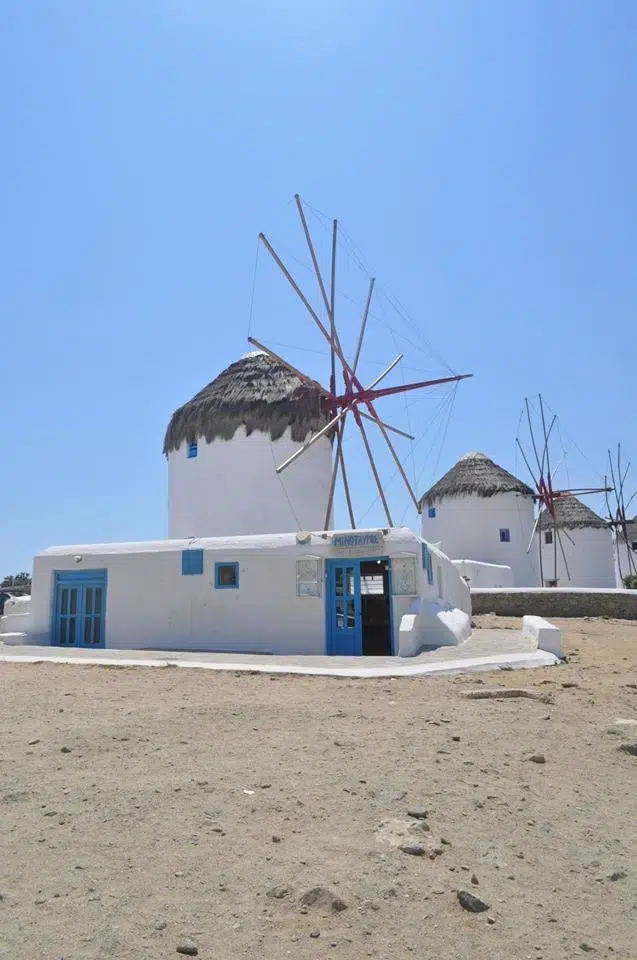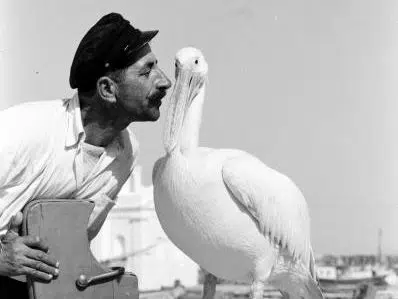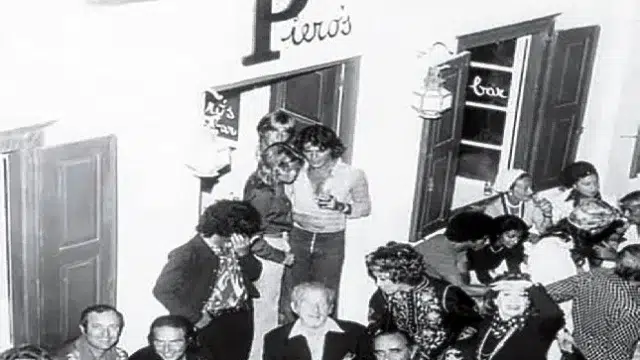Before dipping your toes in the Mykonos allure, make sure you read these fun Mykonos facts about the celebrated island!
- Mykonos is a Cycladic island in the Aegean Sea, particularly famous for its summer party vibe and extravagant lifestyle. It covers an area of around 105km and lies between the islands of Naxos, Paros, Syros, and Tinos.
- There are slightly over 10,000 permanent residents on the island (2011 census). However, during the summer months, you may see just as many visitors on cruise ships docking at the port in a day. Overall, more than two million tourists decide to get a taste of Mykonos every year.
- Mykonos’ nickname is The Island of the Winds due to the strong Meltemi winds that blow often but it may also be referred to as the Queen of the Cyclades.
- The majority of the population lives in Chora or Mykonos Town, the largest town of the island, which is also considered the island capital.
- Despite its small area, there are more than 600 churches and small chapels at Mykonos, most of them dating back to the Byzantine times. It is estimated that there is one church per local family! Mykonos Town alone hosts 60 of them, with Panagia Paraportiani being the most famous and most photographed one. The iconic landmark is located in the Kastro neighbourhood and was built in 1475 (was eventually completed in the 17th century, though).
- According to Greek mythology, the island got its name from Mykonos, its first ruler, who, many believe, was a descendant of the Greek God of Light and Music, Apollo. It is also said that Mykonos hosted the legendary fight between the Titans and the highest of the gods of Olympus, Zeus. When the father of all gods defeated the Titans, he imprisoned them under the island’s rocky terrain in a region called Houlakia or Choulakia, where they (allegedly) still remain.

- The 19-metre-tall Armenistis Lighthouse is one of the most beautiful sights in Mykonos. It dates back to 1891 (some people say, 1894) and is home to pristine views and seascapes. Armenistis Lighthouse occupies a space in the Fanari region, 7km from Mykonos Town and its focal height exceeds 180 meters.
- Little Venice is one of the most romantic and idyllic spots on Mykonos Island, Greece. Its original name is Alefkandra but it slipped into a more touristy version due to the resemblance the local authorities believed this place had to the Italian city of Venice. With Venetian influences evident all around – Mykonos was under Venetian rule from the 14th century until the 18th century—Little Venice impresses with the colourful houses whose balconies literally hang above the sea (once residences of sea captains and wealthy merchants). Besides the gorgeous sunset views, this quaint neighbourhood also offers a plethora of entertainment options, from cafes and bistros to bars, tavernas, and restaurants. It should also be noted that, during the 1950s and 1960s, Little Venice used to host a school where fishing was part of the curriculum!

- The construction of the famous Mykonos windmills begun in the 16th century by the Venetians. At that time, grain production (wheat, in particular) was the primary occupation of Mykonos residents and the windy weather created the ideal conditions to operate a windmill. Over time, the focus has shifted from grain production to tourism, making the windmills a scenic landscape for visitors to visit. Today, some 16 windmills survive on the island, with 5 of them sitting on a straight strip of land (aka Kato Mili), offering staggering views of the Aegean Sea, the beautiful coastline, and the picturesque Little Venice. One of the remaining windmills is turned into a museum dedicated to the agriculture and Mykonos history of the place, while Geronymos Mill, the oldest still standing, is privately owned.
- Mykonos was once a popular pirate hub. In the 1900s, when pirates used to own the seas the way we all know, Mykonos was the place where pirates would gather, sing, drink, and had fun until they dropped.
- According to strict colour code, the windows and doors in Mykonos should be painted blue, green, or red as a means to maintain the authenticity of the island – sailors back in the day used blue to paint their windows and doors, farmers painted them green, and red was used from everyone else. The walls are usually whitewashed, which makes a beautiful contrast with the colourful doors and windows.
- Mykonos-owned Delos island was declared a UNESCO World Heritage Site in 1990. In the Hellenistic years (during the Peloponnese War, to be precise), though, the Athenians decided to purify Delos. No woman was allowed to have children and no person could be buried or have their funeral there.
- Mykonos was poverty-stricken until the 1950s, when the bohemians and artists first, and then the royals and the a-lists, discovered the island. This led to the gradual transformation of Mykonos from a relatively barren island into a party mecca that caters for an upmarket clientele, with elegant, exclusive Mykonos luxury villas, elite restaurants, luxury boutiques, VIP beach bars, and more.

- Petros the Pelican is the island mascot. The story begins in 1958, when a white pelican was found injured off the coast of Mykonos. The fisherman who found the bird nursed it back to life and it quickly became locals’ favourite, who nicknamed him Petros. Petros was so loved that the Mykonians once fought a custody case over him when he flew to the neighboring island of Tinos and locals decided they wanted to keep him! Petros was returned to Mykonos, where he was welcomed with a big party with lots of drinks, food, and music. From then on, thousands of visitors have been photographed with the friendly pelican until 1985, when he was killed by a car. To soothe the locals’ mourning and grief, both Jackie Kennedy Onassis and the zoo of Hamburg donated a pelican each (called Irene and Petros). Some years later, another wounded pelican landed in Mykonos, was treated by the locals, and was nicknamed Nikolas. Should you walk the streets of Mykonos, have a look around for any of these birds and, why not, pose with it for an Instagram picture (or two)!
- The most legendary gay bar on the island was Pierro’s bar. It opened in 1973 and hosted some of the most renowned parties of the time, attracting the crème de la crème of the ‘70s, 80’s and 90’s.

- There are over 40 beaches in Mykonos, four of which are nudist beaches. Among the most populated are Super Paradise, Elia, and Paraga beach, where the craziest parties take place, while you will also find lots of secluded bays and coves to meet your requirements for privacy and tranquility.
- Mykonos is a top LGBT-friendly destination, with special events organised during the summer months specifically for the LGBT community.
- The vibrant night scene of Mykonos is fabled. Two of the top 20 clubs in the world are located here (according to a DJ Magazine vote contest for the best clubs of the decade). Here, party goers are treated with ground-breaking music, the most talented DJs, and the most energetic atmosphere. Today, Mykonos has over 100 bars and clubs, and counting. It is also said that the most expensive champagne in Greece is served at Nammos restaurant, costing 125,000 euros per bottle (Armand De Brignac Methuselah Midas).
- There are more than 70 country fairs to attend, with more than half of them taking place during the summertime.
- Taxis are a bit hard to find in Mykonos, which is why many tourists prefer to rent motorbikes, ATVs or even luxury vehicles, Jeeps, helicopters, and luxurious catamarans and yachts for their private tours and island hopping needs.
- Mykonos enjoys more than 300 days of sunshine and mild weather. The Meltemi winds protect it from the scorching temperatures that rage Europe every year.
Curious about what we do? Visit the About Us page at Kinglike Concierge. Now that you’ve learned some intriguing facts about Mykonos, discover which celebrities consider Mykonos eternal love. Explore amazing Mykonos dive sites, delve into the history of Mykonos, and choose the perfect place to stay with our accommodation guide. Visit the serene Panagia Tourliani Monastery, relax on the best beaches in Mykonos, and don’t miss a trip to Rhenia Island.